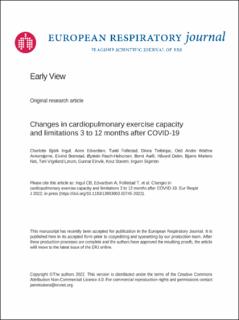| dc.contributor.author | Ingul, Charlotte Bjørk | |
| dc.contributor.author | Edvardsen, Anne | |
| dc.contributor.author | Follestad, Turid | |
| dc.contributor.author | Trebinjac, Divna | |
| dc.contributor.author | Ankerstjerne, Odd Andre Wathne | |
| dc.contributor.author | Brønstad, Eivind | |
| dc.contributor.author | Rasch-Halvorsen, Øystein | |
| dc.contributor.author | Aarli, Bernt Bøgvald | |
| dc.contributor.author | Dalen, Håvard | |
| dc.contributor.author | Nes, Bjarne | |
| dc.contributor.author | Lerum, Tøri Vigeland | |
| dc.contributor.author | Einvik, Gunnar | |
| dc.contributor.author | Stavem, Knut | |
| dc.contributor.author | Skjørten, Ingunn | |
| dc.date.accessioned | 2023-02-08T14:53:46Z | |
| dc.date.available | 2023-02-08T14:53:46Z | |
| dc.date.created | 2022-11-17T10:25:50Z | |
| dc.date.issued | 2023 | |
| dc.identifier.issn | 0903-1936 | |
| dc.identifier.uri | https://hdl.handle.net/11250/3049422 | |
| dc.description.abstract | Rationale: To describe cardiopulmonary function during exercise 12 months after hospital discharge for coronavirus disease 2019 (COVID-19), assess the change from 3 to 12 months, and compare the results with matched controls without COVID-19.
Methods: In this prospective, longitudinal, multicentre cohort study, hospitalised COVID-19 patients were examined using a cardiopulmonary exercise test (CPET) 3 and 12 months after discharge. At 3 months, 180 performed a successful CPET, and 177 did so at 12 months (mean age 59.3 years, 85 females). The COVID-19 patients were compared with controls without COVID-19 matched for age, sex, body mass index and comorbidity. Main outcome was peak oxygen uptake (V′O2 peak).
Results: Exercise intolerance (V′O2 peak <80% predicted) was observed in 23% of patients at 12 months, related to circulatory (28%), ventilatory (17%) and other limitations including deconditioning and dysfunctional breathing (55%). Estimated mean difference between 3 and 12 months showed significant increases in V′O2 peak % pred (5.0 percentage points (pp), 95% CI 3.1–6.9 pp; p<0.001), V′O2 peak·kg−1 % pred (3.4 pp, 95% CI 1.6–5.1 pp; p<0.001) and oxygen pulse % pred (4.6 pp, 95% CI 2.5–6.8 pp; p<0.001). V′O2 peak was 2440 mL·min−1 in COVID-19 patients compared to 2972 mL·min−1 in matched controls.
Conclusions: 1 year after hospital discharge for COVID-19, the majority (77%), had normal exercise capacity. Only every fourth had exercise intolerance and in these circulatory limiting factors were more common than ventilator factors. Deconditioning was common. V′O2 peak and oxygen pulse improved significantly from 3 months. | en_US |
| dc.language.iso | eng | en_US |
| dc.publisher | European Respiratory Society | en_US |
| dc.rights | Navngivelse-Ikkekommersiell 4.0 Internasjonal | * |
| dc.rights.uri | http://creativecommons.org/licenses/by-nc/4.0/deed.no | * |
| dc.title | Changes in cardiopulmonary exercise capacity and limitations 3 to 12 months after COVID-19 | en_US |
| dc.type | Journal article | en_US |
| dc.type | Peer reviewed | en_US |
| dc.description.version | publishedVersion | en_US |
| dc.rights.holder | Copyright 2023 the authors | en_US |
| dc.source.articlenumber | 2200745 | en_US |
| cristin.ispublished | true | |
| cristin.fulltext | original | |
| cristin.qualitycode | 2 | |
| dc.identifier.doi | 10.1183/13993003.00745-2022 | |
| dc.identifier.cristin | 2075366 | |
| dc.source.journal | European Respiratory Journal | en_US |
| dc.relation.project | Norges forskningsråd: 237887 | en_US |
| dc.identifier.citation | European Respiratory Journal. 2023, 61 (2), 2200745. | en_US |
| dc.source.volume | 61 | en_US |
| dc.source.issue | 2 | en_US |

